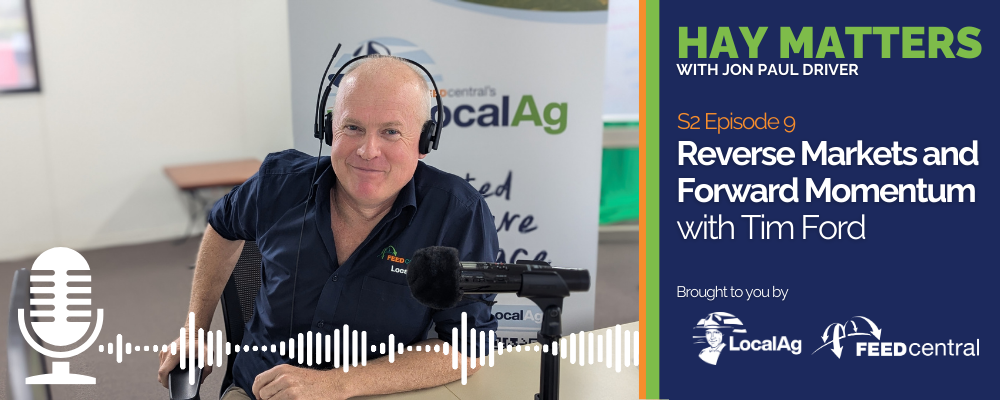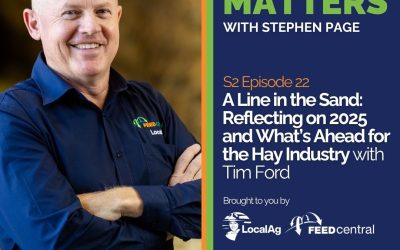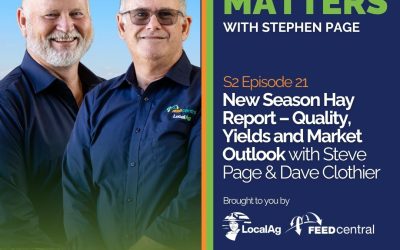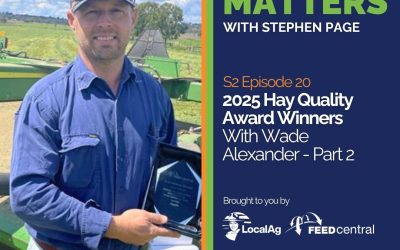
Podcast Highlights
In the latest episode of Hay Matters from Feed Central and LocalAg, our host Jon Paul Driver catches up with Director Tim Ford to discuss the current market and LocalAg’s first quarter.
As southern sheds sit nearly empty, Queensland hay has begun heading south in a reversal of traditional seasonal movement. With biosecurity concerns under control in most areas and demand climbing, the coming weeks could see more sheds open if rain arrives.
Meanwhile, the LocalAg platform is handling high volumes well, and buyer demand has led to the introduction of LocalAg Plus, re-introducing delivered pricing and logistics for those who want a hands-off experience.
Market Update:
- Australia is experiencing extreme weather contrasts, with parts of Western Queensland recovering from floods while South Australia and Victoria face severe drought.
- Queensland hay is now moving south in increasing volumes, a major shift from the usual supply direction. Local supply in Southern Australia is limited, but strong recent seasons mean there’s still stock available.
- Key seasonal milestones, including Anzac Day and Mother’s Day, have passed without rain in many southern regions, increasing concerns about the coming winter.
- If forecast rain fronts materialise, more sheds may open across southern states. Sellers are watching conditions closely, and timely rainfall could ease some market pressure.
- Biosecurity restrictions are in place for some small regions of South East Queensland due to fire ants, but most of Queensland remains unaffected and compliant, meaning hay can still move safely with the correct biosecurity certification.
- Prices are climbing: $400/tonne for cereal hay and $450–$500/tonne for lucerne.
LocalAg Update
- Buyer demand is strong, with listings moving quickly across the platform.
- The system has handled recent market pressure well, giving sellers national exposure and fast results.
- We’ve listened to buyer feedback, and introduced LocalAg Plus to offer the delivered pricing model many of our users were familiar with on Feed Central.
- We’re seeing a positive response to payments handled securely via escrow, as sellers appreciate the peace of mind, speed of payments and buyers and sellers can deal directly.
- If you’ve got quality fodder, now’s an ideal time to list, with high seasonal demand meaning stock is moving fast on LocalAg.
Additional Biosecurity Resources:
Read Transcript
Jon Paul Driver:
Welcome to the Hay Matters podcast brought to you by LocalAg and Feed Central. This is your go to source for all things hay related in Australia. I’m your host, Jon Paul Driver. In today’s episode, we’re joined by Tim Ford, Founder and Managing Director of Feed Central and LocalAg. Welcome back.
Tim Ford:
Great to be here, JP. It’s great to be on the podcast again with you. Now there’s a lot going on in the marketplace. Where would you like to start?
Jon Paul Driver:
Wow. Let’s talk about drought in the South and too much water in the North.
Tim Ford:
That’s a great place to start, JP. It’s, I suppose we think it’s extraordinary, but those of us that have been around for a long time know that Australia is extreme. It’s just right now, it seems a little bit more extreme than ever.
Many of our communities are just recovering or in the process of starting to recover from a very prolonged flooding event in Western Queensland, where some parts of the continent received annual rainfall or two years rainfall overnight. And that’s sending a lot of water down into Lake Eyre in the top end of South Australia there. I think most people are across that story. It did receive a lot of headlines. We had, you know, lots of images of hay being dropped out of helicopters and lots of images of dead sheep and dead cattle and communities that have been torn apart by those floodwaters, and that’s truly devastating. I think in total there, I was talking to the boss of rural aid, just the other day, and it was approximately a thousand tonnes, in total that got dropped, from the helicopters sort of on a on a bail by bail basis. So that’s, you know, an incredible effort by the, by the charity, rural aid and other charities that have been involved. And it was backed and supported by the state government and Ag Force as well. So there’s been a tremendous effort there. There’s been, you know, probably a similar quantity of hay going to that region, on the trucks.So overall, there’s, you know, in that flood region, it is a very vast grazing area. So it’s not an intensive livestock area by any stretch of the imagination. So there’s probably been about 2,000 tonnes or a little bit more, which is a relatively small amount. And the fodder market has been able to handle that without a significant impact on the market. As opposed to the Lismore floods back in 2022, where it was much more intensive in agriculture, much more intensive livestock dairy region, those Lismore floods had a direct impact on the fodder market that perhaps the Western Queensland floods haven’t had. But the big story for the fodder market is the dry in the South. That’s really significant. And lots and lots of our clients, suppliers, sellers are heavily impacted by that. And that’s a serious story for the FOTA market.
Jon Paul Driver:
And I get the sense that the tension in the marketplace is rising.
Tim Ford:
Yeah. That’s a good point. There is tension in the marketplace. There’s a real anxiety about the supply. There are key, key dates have passed, you know, in my view, the fodder market kicks off after Australia Day when the kids go back to school, after the summer holidays, you know, from February 1, the market kicks off, and that certainly happened this year. The next key date is April Fools’ Day on the April 1 where we’re starting to cool down and people are starting to think about buying hay, and that certainly came true this year. The next key date is Anzac Day, where we’d like to see the majority of the southern regions to have had their winter autumn break. And, you know, that date has passed, and there’s been no rain of significance through vast areas of South Australia and Victoria. And then May 10 has passed, and May 10 is another one of those psychological dates where if it hasn’t rained by May 10, then we’re in for a long, hard winter, where pasture growth just get moderate, very low levels of pasture growth. You know, if we do get winter rain through those winter rainfall regions, we’ve got to remember those regions are predominantly winter rainfall, and predominantly a winter based pasture system. So clover, rye based pasture systems that should be well established in autumn, with some moderate growth through winter and then lots of growth during spring, but there’s just zero pasture.
Jon Paul Driver:
So you were recently in South Australia. What were your takeaways?
Tim Ford:
Great. I love South Australia. Very, very, you know, awesome place, awesome people, awesome countryside. I was in South Australia and did a tour of our did a tour of our farms and of our many of our clients’ farms in that region and very fortunate enough to get in the aeroplane with a couple of our clients and have a good look around. And, yeah, look, it’s extremely dry. That was just before Easter, and it was it was just crackingly dry, as dry as I’ve ever seen South Australia. And the place was ready to blow in that, you know, the winds were starting and the dust was just ready to go. The the soils are very fragile, and the ground cover is very low. And and the sheep I grew up with sheep and just sort of have this innate sense of when sheep are hungry. And, you know, they’re walking fast across the paddock with no dog or person behind them. They’re searching for feed and their heads are down and they’re walking fast and they’re raising dust as the as the sheep are walking across the paddock. And so you’re just incredibly dry. And, you know, talking to, generational farmers down there and got four generations working on the farm. And, you know, the grandfather who comes to the farm daily, he’s in his nineties. He he has experienced it this dry before, but none of the other generations working on that farm have he’s have experienced that. So, yeah, well, I just think from, sitting here in Queensland, it’s just really not possible to I know we have plenty of droughts, and we’ve had plenty of droughts, but until you go there and see it personally, you just don’t get the full comprehension of it. So you know, it’s a very significant drought. And the impact on that to the industry is, that’s the question that we can unpack, I suppose.
Jon Paul Driver:
So, hay doesn’t usually flow Queensland south. It’s usually the other way around.
Tim Ford:
Yeah.
Jon Paul Driver:
Will there be any restrictions thinking about biosecurity restrictions?
Tim Ford:
Yeah.
Jon Paul Driver:
What is it that the growers need to know? We’re days away from seeing Queensland supplying hay into South Australia, if it hasn’t already happened. So there’s a couple of key messages there for our Queensland buyers. There’s a very strong, there’s a very strong message that there’s a level of complacency in Queensland, because the seasons have been just so good, which is absolutely extraordinary. You know, I’ve been living and working on the Darling Downs for thirty plus years, and I haven’t seen, the downs have a run or Southern Queensland have a run of good seasons like we’ve had. So the level of complacency about hay supply has come into the market in Queensland. Our buyers just need to be really careful of that because the hay is going to slip south really, really quickly. In in historical terms, we would never ship hay from Queensland South, like we would never really we would never ship hay even from Queensland to New South Wales, even to our neighbours next door, that the hay wood historically come south, you know, Southern Australia has very, very good production systems for bulk dry matter of very hay quality hay. So bulk dry matter of cereal hay, especially it’s a winter based rainfall system, it’s a winter based growing system. And historically, traditionally, Southern Australia would produce large volumes of dry matter in making the hay cheap and affordable and still viable for the growers in Southern Australia, where that just doesn’t happen in Queensland. So we just don’t get the bulk. So it’s like trying to grow sorghum in Victoria. You don’t grow lots of hay in Queensland, because it’s just what the natural system tells us to do. So we’ve now got all our production regions, suffering, you know, an extensive shortfall. And not only that, they don’t yet have next year’s crop planted or they might be planting it, but they’re planting it dry. So it’s not sort of germinated. So and every day that goes, yields fall back because the production season is shortening up now. So we’ve got the vast majority of our supply region totally exhausted of hay supply, like the vast majority of South Australia and Victoria ninety percent of Australia’s hay comes out of Victoria. And then you know, and then the rest comes out of South Australia, basically. So you’ve got Victoria, that’s basically, basically every shed empty. You’ve got South Australia, that’s basically every shed empty, because it’s not their first dry year, this had they’ve had two or three dry years on the trot now. And, and then you’ve got New South Wales has had some pretty good seasons. So there is a buildup of hay in New South Wales, it’s being sold down rapidly. And then there’s a buildup of hay in … there’s a little bit of hay in Southern Queensland, that’s going to be sold down fairly rapidly, fairly soon. You know, I said to the team here a couple of days ago, there was a few hours here the other day where our office was as busy as it has ever been. And, you know, we’ve been through the millennial drought, we’ve been through the droughts during the 2000s, we’ve been through the 2017/18/19 drought, where the phones were incredibly busy. You know, the other day, the phones for a few hours there, the phones were as busy as they’ve ever been. And then plus the websites, plus the mobile phones, etcetera, etcetera. So, you know, there’s no doubt that there’s a really significant event happening at the moment, that’s having a really big impact on the fodder market.
Jon Paul Driver:
As we consider the, that hay movement from Queensland South, take me through the biosecurity concerns.
Tim Ford:
Well, that’s it too. That’s a really good consideration that we’ve never had to have before. And, the biosecurity, issues that are happening, there is a there is a very small area of Queensland that is in a biosecurity, security, lockdown area for fire ants, and that is basically a very small region, around the Lockyer Valley, you know, Gatton, Laidley as the two main towns there and up to some regions in the Gold Coast. That Lockyer Valley is traditionally a large hay production region in Queensland, but we’ve got to put that in perspective because Queensland is not a major hay production state, and that particular part of the world is predominantly small, small bales for the equine industry in Brisbane, Sunshine Coast, Gold Coast. So it’s not a it’s not, historically, doesn’t have a strong place in the national market of hay. However, there is a message out there that all hay from Queensland has fire ants, and that’s definitely not the case. It’s a very small region. The Queensland government has been quite active in suppressing the fire ants. They don’t necessarily have them under control, but they’ve done a good job in suppressing them. And in some regions that, you know, in some regions, they’re not under control, but they’ve certainly been suppressed to a certain to a to a very small geographic region in the scheme of things. And there is a total ban, taking hay out of those regions into New South Wales. Taking hay out of those regions into Queensland is subject to certain biosecurity protocols, which, the majority of growers are achieving. Then the rest of Queensland is fire ant free. So the key message here is that the vast majority of Queensland is fire ant free and the growers and the industry has a pretty good handle on who’s affected and who’s not affected.
Jon Paul Driver:
Sum it up for me, Tim. What’s the risk of moving hay out of Queensland in the, in the non, fire ant areas?
Tim Ford:
The risk would be as negligible as anywhere else in the country. So there’s, you know, buying hay out of the Darling Downs, for example, the risk of getting fire into the Darling Downs would be as low as getting fire ants out of the Riverina. You know, or out of Northern New South Wales, there is just no fire ants reported in the areas outside of that. So, you know, really buyers should be really comfortable in buying hay out of Queensland. There will be some biosecurity protocols and we’ll, we’ll, we’ll put that in the, in the show notes and the newsletter that goes with this podcast. We’ll get the specifics of those. But for example, this fire ant issue in Queensland has resulted in the South Australian government, putting restrictions on the movement of hay and into South Australia from any state. So if you’re wanting to take hay into South Australia from any state, you need a plant health certificate, which be provided from the, South Australian Department of Primary Industries. And we’ll put specifics. We’ve got experts in our business that have been, really honing in on this. So we’ll put we’ll put the details in the show notes. But there are restrictions in moving hay from any state into South Australia, which is something that we need to be careful with. To date, it hasn’t caused a major problem. The turnaround time has been very good. It’s just something that, as an industry, we need to be aware of.
Jon Paul Driver:
Alright. Do you wanna talk hay prices?
Tim Ford:
Yeah. We can talk hay prices. So where are we at on oaten hay? Yeah. Look. Oaten hay, the key point is availability. So through Victoria, availability is low and Oat and Hay prices for, you know, what we would regard as a feed central A grade, visual A grade quality would be, around that $400 a tonne ex fire mark. And loosen would be, depending on quality, you know, potentially $4.50 to 500 or a little bit more for the really good quality product. And then vetch is basically unavailable, unfortunately. And then the straw market is very, very tight in the supply of straw. So overall, the market is very tight. There is still some product coming into the system, so it’s not completely exhausted. But there’s still some product coming into the system.
Jon Paul Driver:
Okay. Let’s shift gears here and talk about LocalAg, LocalAg Plus, and Feed Central. There’s some new names here, and let’s try to get folks familiar with them.
Tim Ford:
Yeah. Look. A lot of people would be familiar with that we launched our LocalAg as a new platform, a new ecommerce platform earlier in the year. The it’s the recent really busy period in the Haymarket has really put LocalAg through its paces, and perform really well. So basically what we did was we shut down the very well known Feed Central Marketplace or the Feed Central Buy Now page where there was lots and listings of hay all graded, feed tested, and was giving out delivered prices. And we shut down that site and redirected, buyers over to the new LocalAg platform. And we did a previous podcast, about that, about the time we were doing it. We are now, four months in and or a little bit more than four months in. And we’ve, yeah, we’ve had a lots and lots and lots of feedback and lots and lots of, learnings out of that.
Jon Paul Driver:
Let’s go through LocalAg versus LocalAg Plus.
Tim Ford:
Yeah. You’re ahead of yourself here, JP. LocalAg Plus. So so we got lots of feedback. We were always planning on LocalAg Plus, but we had to bring it forward because we had lots of feedback that the buyers wanted the delivered price. And it was interesting because when we had only the delivered price, we got lots and lots… And when we had delivered price, we had lots and lots of questions about what’s the ex farm price. So we sort of go, you know, under the old system, it’s always been, what’s the ex farm price? And then we took the we took the lot the delivered price away and went back to ex-farm prices, and then everyone wanted the deliver prices. So we hadn’t got rid of that code at all.
So we were able to quickly reinstate, as LocalAg Plus the delivered prices, which is something we’re always planning on doing. But we were we were thinking that it could be done later in the year. But with the demand and everything, we were able to quickly reinstate LocalAg Plus. So what LocalAg Plus does is it gives delivered prices. So when people are on the LocalAg website, they will see some little flags where they can get delivered prices. And and it just takes them to another page that’s very similar and it and allows instead of getting ex farm price, it gets delivered prices including freight and all the fees and everything else. So it was great to get that feedback, and it was fantastic that the team was able to respond to that, so quickly and get that up and running. That’ll be there. It’ll be there permanently now. And that was about the first, the first big, the first big lot of feedback that we got. So, you know, where we’re at now is just getting the feedback from clients and responding to it. Because, you know, more and more, as I said, in the original podcast, where we started talking about LocalAg, there’s just that group of clients that are just that just come around the business. And when we do something like this, they get engaged, and they give us feedback. And that’s exactly what’s been happening. And that’s really awesome. And, you know, we’re very appreciative of that feedback. I wish we could action all of it immediately, but sometimes we have to stage it, and to be able to, to be able to achieve it.
Jon Paul Driver:
And just for clarity, Feed Central is not completely gone.
Tim Ford:
No. No. No. So Feed Central, where we wanna get to, and we’re aiming to get there, for the July 1, is that essentially we want to have Feed Central as the quality assurance business. And, and there’s an increasing role for Feed Central Quality Assurance Business as a biosecurity, quality assurance, on farm visual testing and grading of hay, as well as, inventory management, assisting growers with inventory management, and also quality assurance, NIR, on farm quality assurance, and lab feed testing and so forth. So really wanna separate Feed Central to be that dedicated hay quality assurance company, which is what it’s really well known for. And then LocalAg becomes a platform, and then they operate as two separate companies.
Tim Ford:
And then LocalAg Plus is for those buyers wanting delivered prices, wanting personal service, account management, and so forth. So, it will be a little bit for clients to get used to but fundamentally, within the market, I believe there’s a need for a dedicated quality assurance business for the fodder industry and then, there’s a need for the separate market place and trading mechanism. And LocalAg is the trading marketplace. And then LocalAg Plus is where there’s account management, personalised service, 100% of trucks, and contracts being managed and trucks being managed by our team and so forth. So it’s sort of we’re unpacking and discovering new markets and so forth within the fodder industry. But then, you know, LocalAg in particular being that marketplace will have opportunity for the clients that love the way we do things can go on and list other products like grain, cattle, sheep. You know, we’ve got some vehicles advertised and so forth. But our fundamental core that we’re wanting to focus on at the moment is that hay business and separating the quality assurance business from the, ecommerce platform. And, you know, that’s work in progress, but we’re certainly, we’re certainly making great headway in getting that done. And then we expect to have all of these changes, new marketing material, new company, and so forth established for that July 1 this year, which is obviously our financial year.
Jon Paul Driver:
All right. Well with that, Tim, thank you very much for sharing your market insights with us and talking about the development of LocalAg. It’s fun to watch and learn as we go. Again, I’ve been joined by Tim Ford, the Founder and Managing Director of Feed Central and LocalAg.
Tim Ford:
Great to be here, JP. Always a pleasure.
Jon Paul Driver:
Alright. This podcast is proudly presented by Feed Central and LocalAg. Stay tuned in for upcoming episodes.



